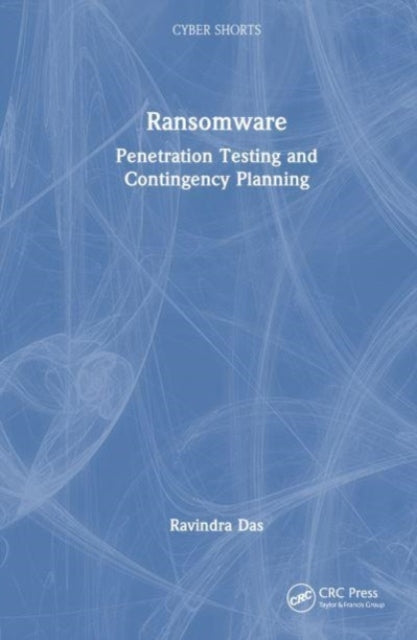RavindraDas
Ransomware: Penetration Testing and Contingency Planning
Ransomware: Penetration Testing and Contingency Planning
YOU SAVE £5.76
- Condition: Brand new
- UK Delivery times: Usually arrives within 2 - 3 working days
- UK Shipping: Fee starts at £2.39. Subject to product weight & dimension
Bulk ordering. Want 15 or more copies? Get a personalised quote and bigger discounts. Learn more about bulk orders.
Couldn't load pickup availability
- More about Ransomware: Penetration Testing and Contingency Planning
Ransomware is a poorly understood subject, but penetration testing can be used to combat it. Other controls will also be examined.
Format: Hardback
Length: 122 pages
Publication date: 21 December 2023
Publisher: Taylor & Francis Ltd
Ransomware is a complex and poorly understood subject that continues to pose significant threats to individuals and businesses alike. In this article, we will delve into the anatomy of a ransomware attack, exploring how it all happens and the potential risks associated with it.
Understanding the anatomy of a ransomware attack is crucial in order to develop effective strategies for prevention and mitigation. Here are some key aspects to consider:
Virus Infection: Ransomware attacks typically begin with a virus infection. The virus is often spread through email attachments, malicious websites, or by downloading infected software. Once the virus infects a system, it can gain access to sensitive data and encrypt it, making it inaccessible to the user.
Cryptographic Encryption: The ransomware virus uses powerful cryptographic algorithms to encrypt the victim's data. This encryption makes the data unusable without the decryption key, which is typically held by the attacker.
Extortion Demand: After encrypting the victim's data, the attacker will demand a ransom in exchange for the decryption key. The ransom amount can vary widely, depending on the extent of the damage caused by the attack and the perceived value of the data.
Payment and Release: In some cases, the victim may choose to pay the ransom to the attacker in order to regain access to their data. However, paying the ransom does not guarantee the release of the decryption key, and there is no guarantee that the attacker will not encrypt the victim's data again in the future.
It is important to note that ransomware attacks can have serious consequences for individuals and businesses. Lost data can result in financial losses, reputational damage, and operational disruptions. Additionally, some ransomware attacks can target critical infrastructure, such as hospitals or power grids, causing widespread harm.
To combat ransomware attacks, there are several strategies that can be implemented. One of the most effective methods is penetration testing, which is regarded as one of the best ways to keep individuals and businesses safe. Penetration testing involves testing the security vulnerabilities of a system or network to identify potential weaknesses that could be exploited by attackers.
Other controls that can be examined to combat ransomware attacks include:
Regular Software Updates: Keeping software and operating systems up to date with the latest security patches can help prevent many ransomware attacks.
Strong Password Policies: Implementing strong password policies and regularly updating them can help prevent unauthorized access to sensitive data.
Multi-Factor Authentication: Enabling multi-factor authentication, such as two-factor authentication, can add an extra layer of security to user accounts and prevent unauthorized access.
Backup and Recovery: Regularly backing up critical data to an off-site location can help prevent data loss in the event of a ransomware attack.
Employee Education: Educating employees about the risks of ransomware attacks and how to identify and prevent them can help reduce the risk of an attack.
In conclusion, ransomware is a complex and evolving threat that requires a comprehensive approach to prevention and mitigation. Understanding the anatomy of a ransomware attack, as well as the potential risks associated with it, is essential for developing effective strategies to keep individuals and businesses safe. Penetration testing, regular software updates, strong password policies, multi-factor authentication, backup and recovery, and employee education are all important controls that can be examined to combat ransomware attacks. By implementing these measures, organizations can reduce the risk of falling victim to a ransomware attack and minimize the potential damage caused by such an attack.
Weight: 400g
Dimension: 234 x 156 (mm)
ISBN-13: 9781032556673
This item can be found in:
UK and International shipping information
UK and International shipping information
UK Delivery and returns information:
- Delivery within 2 - 3 days when ordering in the UK.
- Shipping fee for UK customers from £2.39. Fully tracked shipping service available.
- Returns policy: Return within 30 days of receipt for full refund.
International deliveries:
Shulph Ink now ships to Australia, Belgium, Canada, France, Germany, Ireland, Italy, India, Luxembourg Saudi Arabia, Singapore, Spain, Netherlands, New Zealand, United Arab Emirates, United States of America.
- Delivery times: within 5 - 10 days for international orders.
- Shipping fee: charges vary for overseas orders. Only tracked services are available for most international orders. Some countries have untracked shipping options.
- Customs charges: If ordering to addresses outside the United Kingdom, you may or may not incur additional customs and duties fees during local delivery.


